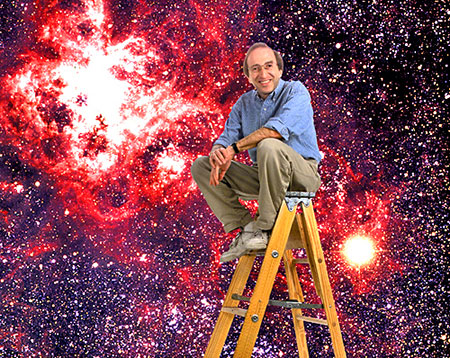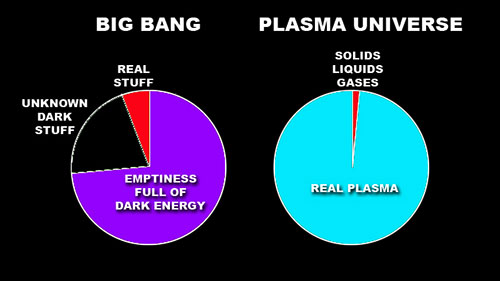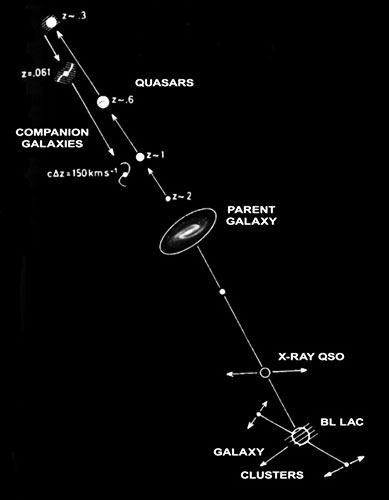|
by Wal Thornhill October 6, 2011 from HoloScience Website
Prof. Saul Perlmutter of the University of California, Berkeley, has been awarded half the 10m Swedish krona (US$1,456,000 or £940,000) prize, with Prof. Brian Schmidt of the Australian National University and Prof. Riess of Johns Hopkins University’s Space Telescope Science Institute sharing the other half.
The notion of an accelerating expansion of the universe is based on observation of supernovae at high redshift, known as The High-Z Super Nova Search.
Photo: Lawrence
Berkeley National Laboratory
Photo by Belinda
Pratten.
Calculations show that the energy required is equivalent to 73% of the total mass-energy of the universe! Historians will look back at science today with disbelief and amusement at the ‘science’ of today.
Following equally mysterious ‘black holes’ and ‘dark matter,’ if we continue to discover darkness at the present rate we shall soon know nothing!
I attended a public lecture recently on
"Cosmological Confusion…
revealing the common misconceptions about the big bang, the
expansion of the universe and cosmic horizons," presented at the
Australian National University by an award winning Australian
astrophysicist, Dr. Tamara Davis.
The particular interests of Dr. Davis are the mysteries posed by ‘dark matter’ and ‘dark energy,’ hence the title of this piece.
The theatre was packed and the speaker animated like an excited schoolchild who has done her homework and is proud to show the class.
Her first question to the packed hall was,
It seemed the majority had.
So it was depressing to listen to the questions throughout the performance and recognize that the noted cultural historian Jacques Barzun was right.
Also, Halton Arp’s appraisal of the effect of modern education seemed fitting,
Carl Linnaeus in 1758 showed characteristic academic hubris and anthropocentrism when he named our species Homo sapiens sapiens ("Sapiens" is Latin for "wise man" or " knowing man").
But it is questionable, as a recent (18th August) correspondent to Nature wrote, whether we,
To begin, big bang cosmology dismisses the physics
principle of no creation from nothing. It then proceeds with the
falsehood that Hubble discovered the expansion of the universe. He
didn’t, he found the apparent redshift/distance relationship
(actually a redshift/luminosity relationship), which to his death he
did not feel was due to an expanding universe.
I should like to know what this "fabric" is made from and how matter can be made to shape it? Space is the concept of the relationship between objects in three orthogonal dimensions only. Time is the concept of the interval between events and has nothing to do with Einstein’s physical clocks.
Clearly time has no physical dimension.
David Harriman says,
This is certainly true of Einstein’s theories of
relativity.
The farce must eventually play out like the cartoon character walking off the edge of a cliff and not falling until the realization dawns that there is no support.
But how long must we wait? We are swiftly
approaching the centennial of the big bang. The suspense has become
tedious and it is costing us dearly. Some people are getting angry.
In the words of Brian Schmidt,
He confirms my portrayal of big bang
cosmology as "hope less."
In failing to address these points the Nobel Committee perpetuates the lack of progress in science.
We are paying untold billions of dollars for experiments meant to detect the phantoms springing endlessly from delusional theories. For example, gravitational wave telescopes are being built and continually refined in sensitivity to discover the imaginary "ripples in the fabric of space-time."
The scientists might as well be medieval scholars theorizing about the number of angels that could dance on the head of a pin.
By the end of 2010, the Large Hadron Collider has now cost more than US$10 billion searching for the mythical Higgs boson that is supposed to cause all other particles to exhibit mass!
Here, once again, E=mc2 shows that mass (m) is an intrinsic property of matter. It is futile to look elsewhere for a cause.
In a scientific field, it is dangerous to rely on a single idea. The peril for cosmologists is clear. They have developed a monoculture; an urban myth called the big bang. Every surprising discovery must be force-fitted into the myth regardless of its absurdities.
Scientists are presently so far
‘through the looking glass’ that the real universe we observe
constitutes a mere 4% of their imaginary one.
where 96% of the universe is imaginary. The plasma universe has >99% of the universe
in the form of plasma and
<1% solids, liquids and neutral gases.
Plasma cosmology deals with the dominant (>99%) form of matter in the visible universe.
Plasma cosmology can demonstrate the formation and detailed rotation pattern of spiral galaxies, both by experiment and particle-in-cell computer simulation, using Maxwell’s laws of electromagnetism alone. The puny force of gravity can be ignored!
Plasma cosmology can also explain the activity in the centers of galaxies without resort to the mythical dark gravitational beast - the ‘black hole.'
The
Electric Universe goes further and also explains the gravitational
effects observed at the center of the Milky Way in electrical terms.
So much for the gravitational cosmology of the big bang! No
invisible ‘dark matter’ need be conjured up and placed where needed
to save the plasma model.
It was found that the supernovae in highly redshifted galaxies are fainter than expected, indicating that they are further away than previously estimated. This, in turn, implied a startling accelerating expansion of the universe, according to the big bang model. It is like throwing a ball into the air and having it accelerate upwards.
So a mysterious ‘dark energy’ was invented, which fills the vacuum and works against gravity.
The Douglas Adams’ "Infinite Improbability generator" type of argument was called upon to produce this ‘vacuum energy.’
The language defining vacuum energy is revealing:
You may notice the absurdity of the concept, given that the vacuum contains no matter, ‘background’ or otherwise, yet it is supposed to contain energy.
Adams was parodying Heisenberg’s ‘uncertainty principle’ of quantum mechanics. Quantum mechanics is merely a probabilistic description of what happens at the scale of subatomic particles without any real physical understanding of cause and effect.
Heisenberg was uncertain because he didn’t know what he was talking about.
However, he was truthful when he wrote,
The concept of ‘virtual particles’ winking in and out of existence defies the aforementioned first principle of physics,
Calling that matter ‘virtual’ merely underscores its non-reality.
A supernova type 1a is supposed to be due to a hypothetical series of incredible events involving a white dwarf star. But as I have shown, a supernova is simply an electrical explosion of a star that draws its energy from a galactic circuit.
The remarkable brilliance of a supernova, which can exceed that of its host galaxy for days or weeks, is explained by the kind of power transmission line failure that can also be seen occasionally on Earth.
If such a circuit is suddenly opened, the electromagnetic energy stored in the extensive circuit is concentrated at the point where the circuit is broken, producing catastrophic arcing. Stars too can ‘open their circuit’ due to a plasma instability causing, for example, a magnetic ‘pinch off’ of the interstellar Birkeland current.
The ‘standard candle’ effect and light curve is then simply due to the circuit parameters of galactic transmission lines, which power all stars.
What of the fainter and more short-lived supernovae in highly-redshifted galaxies?
Arp has shown that faint, highly-redshifted objects, like quasars, are intrinsically faint because of their youth and not their distance.
Quasars are ‘born’ episodically from the nucleus of active galaxies. They initially move very fast along the spin axis away from their parent. As they mature they grow brighter and slow down, as if gaining in mass.
Finally they evolve into companion galaxies.
The decreasing quasar redshift occurs in discrete steps which points to a process whereby protons and electrons go through a number of small, quantized (resonant) increases in mass as the electrical stress and power density within the quasar increases. The charge required comes via an electrical ‘umbilical cord,’ in the form of the parent galaxies’ nuclear jet.
Based on Arp’s discovery and the electric model of galaxies and stars, both stars and supernovae type 1a are naturally dimmer, and the supernovae more short-lived, in high-redshift galaxies than in low-redshift galaxies because of the smaller galactic power density and lower mass (energy) of all subatomic particles making up the former.
showing birth of quasars with high-redshift (z) which decreases stepwise as they age and eventually
form
companion galaxies and progenitors of galactic clusters.
Otherwise I could meet the fate of the hapless student who created the ‘Infinite Improbability generator’ in Douglas Adams’ wonderful Hitchhiker’s Guide to the Galaxy,
The use of the title The Dark Side for Dr. Davis’ cosmology talk seems unconsciously apposite.
It was Joseph Campbell who said,
And George Lucas attributes the success of his Star Wars films, which rely on a degenerate, evil ‘dark side,’ to reading Campbell’s books.
The triumph of the big bang myth over common sense and logic supports Campbell’s assessment. And the showbiz appeal of Lucas’ mythic approach to storytelling is evident in the ‘dark side’ of cosmology.
Scientists live their mythology
too. Science’s "cosmic confusion" is self-inflicted.
Sitting in the tame audience the other evening, listening to the professor of astrophysics, I was reminded of The Galaxy Song from Monty Python, which ends with the painfully perceptive lines,
|






